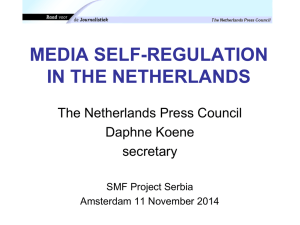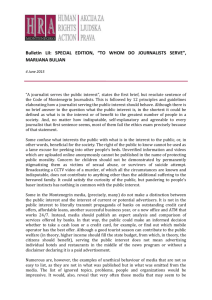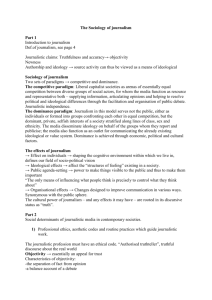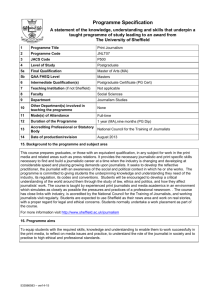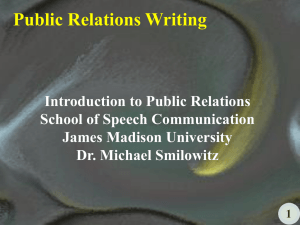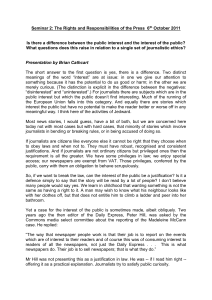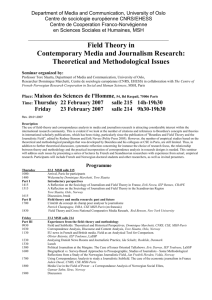15th Nordic Conference on Media and Communication Research
advertisement
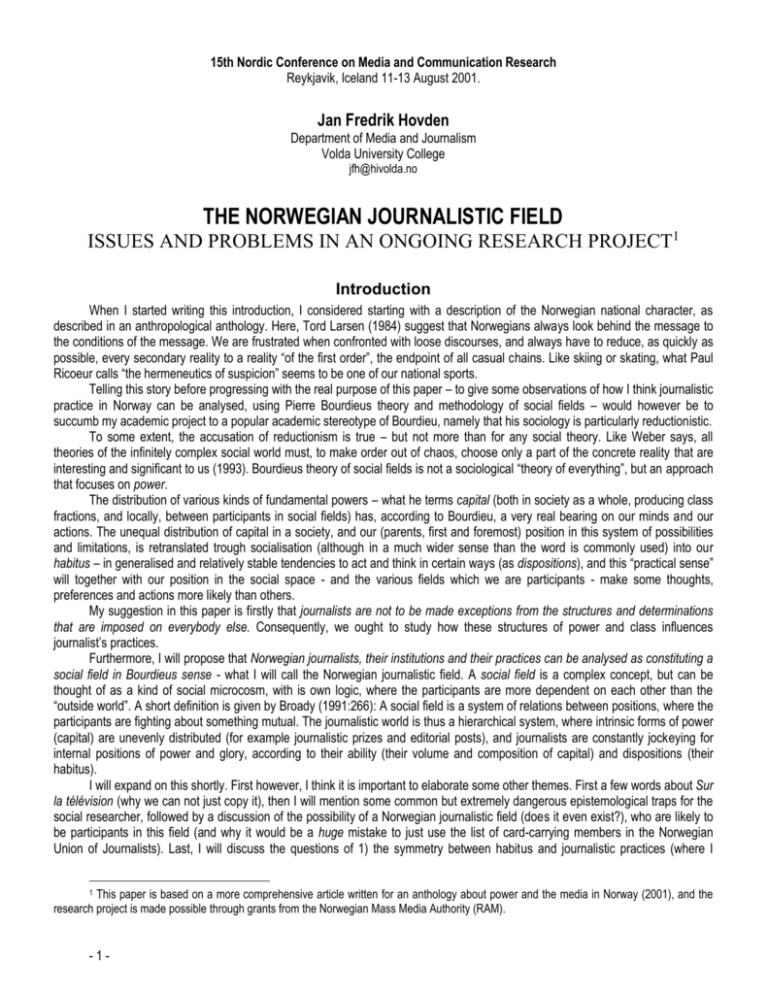
15th Nordic Conference on Media and Communication Research Reykjavik, Iceland 11-13 August 2001. Jan Fredrik Hovden Department of Media and Journalism Volda University College jfh@hivolda.no THE NORWEGIAN JOURNALISTIC FIELD ISSUES AND PROBLEMS IN AN ONGOING RESEARCH PROJECT1 Introduction When I started writing this introduction, I considered starting with a description of the Norwegian national character, as described in an anthropological anthology. Here, Tord Larsen (1984) suggest that Norwegians always look behind the message to the conditions of the message. We are frustrated when confronted with loose discourses, and always have to reduce, as quickly as possible, every secondary reality to a reality “of the first order”, the endpoint of all casual chains. Like skiing or skating, what Paul Ricoeur calls “the hermeneutics of suspicion” seems to be one of our national sports. Telling this story before progressing with the real purpose of this paper – to give some observations of how I think journalistic practice in Norway can be analysed, using Pierre Bourdieus theory and methodology of social fields – would however be to succumb my academic project to a popular academic stereotype of Bourdieu, namely that his sociology is particularly reductionistic. To some extent, the accusation of reductionism is true – but not more than for any social theory. Like Weber says, all theories of the infinitely complex social world must, to make order out of chaos, choose only a part of the concrete reality that are interesting and significant to us (1993). Bourdieus theory of social fields is not a sociological “theory of everything”, but an approach that focuses on power. The distribution of various kinds of fundamental powers – what he terms capital (both in society as a whole, producing class fractions, and locally, between participants in social fields) has, according to Bourdieu, a very real bearing on our minds and our actions. The unequal distribution of capital in a society, and our (parents, first and foremost) position in this system of possibilities and limitations, is retranslated trough socialisation (although in a much wider sense than the word is commonly used) into our habitus – in generalised and relatively stable tendencies to act and think in certain ways (as dispositions), and this “practical sense” will together with our position in the social space - and the various fields which we are participants - make some thoughts, preferences and actions more likely than others. My suggestion in this paper is firstly that journalists are not to be made exceptions from the structures and determinations that are imposed on everybody else. Consequently, we ought to study how these structures of power and class influences journalist’s practices. Furthermore, I will propose that Norwegian journalists, their institutions and their practices can be analysed as constituting a social field in Bourdieus sense - what I will call the Norwegian journalistic field. A social field is a complex concept, but can be thought of as a kind of social microcosm, with is own logic, where the participants are more dependent on each other than the “outside world”. A short definition is given by Broady (1991:266): A social field is a system of relations between positions, where the participants are fighting about something mutual. The journalistic world is thus a hierarchical system, where intrinsic forms of power (capital) are unevenly distributed (for example journalistic prizes and editorial posts), and journalists are constantly jockeying for internal positions of power and glory, according to their ability (their volume and composition of capital) and dispositions (their habitus). I will expand on this shortly. First however, I think it is important to elaborate some other themes. First a few words about Sur la télévision (why we can not just copy it), then I will mention some common but extremely dangerous epistemological traps for the social researcher, followed by a discussion of the possibility of a Norwegian journalistic field (does it even exist?), who are likely to be participants in this field (and why it would be a huge mistake to just use the list of card-carrying members in the Norwegian Union of Journalists). Last, I will discuss the questions of 1) the symmetry between habitus and journalistic practices (where I This paper is based on a more comprehensive article written for an anthology about power and the media in Norway (2001), and the research project is made possible through grants from the Norwegian Mass Media Authority (RAM). 1 -1- present some results from a study of journalism students), and 2) what “assets” in the journalistic world can be said to function as species of capital “...whose possession commands access to the specific profits that are at stake in a field” (Bourdieu & Wacquant 1992:97). Sur la télévision When Bourdieu published Sur la télévision in 1996 (translated in 1998 as On Television and Journalism), it was followed by intense debate in France. It was heavily criticized by media researchers, who called the work unempirical and claimed the book “...does not do justice to a complex situation and portrays the profession quite inaccurately as a homogenous whole” (Marlière 1998:223). Some rationale behind the critique can probably also be found in the fact that many of Bourdieus observations were felt to be “old news” to media researchers (for example the observation that competition between journalists do not lead to pluralism, but similar products). For the project – a study of the Norwegian journalistic field – a few things should be noted about Sur la télévision. Firstly, that it deviates from Bourdieus other field studies. Unlike Homo Academicus (the academic field) and The Rules of Art (the cultural field) it is not based on a dedicated empirical study. Rather, it is probably best understood as a political pamphlet, where Bourdieu warns against the subversive effects the journalistic field has on the field of politics and science, based on his extensive knowledge of these two fields. Secondly, the observations Bourdieu offer on the structure of the French journalistic field should not, as he himself would be the first to point out, be imported directly to other countries. The Norwegian and the French journalistic field are the products of very different histories, and we should not assume that they have a similar structure2. Common and dangerous epistemological traps (and some precautions) There is thus no escaping the empirical work which has to be done (in an Norwegian context), just as there is no escaping what the school of Historical Epistemology (which have been a major influence on Bourdieu, particularly through Bachelard) says are the primary task of the scientist: the construction of a scientific object. Scientific data has no objective existence (which the scientist can “gather”): they have to be “conquered, constructed and verified” (Bourdieu, Chamboredon & Passeron 1991:11). Truly scientific objects can only be achieved through eternal vigilance by the scientist against epistemological obstacles; they must be constructed ”... against experience, against perception, against all everyday technical activity” (Canguilhem 1991:82). The preconstructed is everywhere, and the scientist’s prime enemy is language, which Wittgenstein (1977:18) has accurately described as “an immense network of easily accessible wrong turnings”. This has partly to do with the fact that practical knowledge is rooted differently than scientific knowledge (“Primary self-evidence is not a fundamental truth.”3), but also with the fact that language is never innocent. All classifications are political, in the way that they are a central part of the struggle between (unequal) agents to change or conserve the social order. To give a practical example, let us consider two common terms used when talking about the Norwegian media: “daily press” (dagspresse) and “weekly press” (vekepresse), which in Norway connotes “newspapers” and “glossy magazines”. Why are just these two classifications so often used (and not others)? Just like the classificatory schemes in anthropology – which all journalistic classifications should rightly be considered as types of – there are no reasons to believe that these two terms are so widely used because they are “objectively” very good descriptions of the differences between the institutions, the products they make, or the way they make them. As Durkheim reminds us, widespread use of a term is not a guarantee of it’s objectivity, it only routinizes and naturalizes it, and such help give an appearance of truth (1964:18). If the terms seem “natural”, we should remind ourselves that classificatory schemes from other cultures that are completely alien to us, like the famous Dyribal cosmology (Lakoff 1987:92), are of course just as intuitive to its inhabitants. I believe that one reason for the widespread and continuing use of this separation between “daily” and “weekly” press is that it historically have separated “worthy” and “unworthy” participants in the field as perceived by journalists in the “daily press”, who has succeeded in making their vision of the field dominant (also outside the field). Through this symbolic barrier, some journalists are by their membership bestowed with higher prestige (internally in the field), and a charisma of objectivity/neutrality which are not granted journalists working in the weekly press, even if they should write about the same things in a very similar way. In Bourdieus terminology: they journalists in the “weekly press” are denied access to the symbolic capital of the journalistic field. For example do Bourdieu consider the opposition between the “popular press” (which give news) and “elite press” (which give views) to be a fundamental dimension in the French journalistic field, whereas we do not have this distinction in Norway (consider the “split personality” mix of journalistic forms and themes in Dagbladet). 3 Gaston Bachelard, cited in Canguilhem (1991:83). 2 -2- For such reasons, the greatest mistake we can do as social scientists is to uncritically transform journalistic categories (“journalism”, “PR”, “news”, “entertainment” etc.) into scientific categories. On the contrary, these classifications must themselves be subjected to analysis. If we do not, we are very likely to both be stuck with categories which are not very good for description, and – more critically – to reproduce the relations of power in the field. To exclude the “weekly press” from a study of journalists would be an example of the latter: a scientific consecration of the powers-that-be. A Norwegian journalistic field? Not necessarily... At this point, it is appropriate to remind ourselves that we cannot be sure that a journalistic field – in Bourdieus sense – exist in Norway today. Social fields have no fixed existence: they are born, change their boundaries and disappear trough historic processes. A journalistic field only exist if a sufficient degree of autonomy exists, and therefore a possible result of such a study is that journalistic practice have to be understood as subjected to the constraints of other social fields, for example the economic and/or political field. This is, however, an empirical question, and cannot be answered beforehand. If we look at the “journalistic world” in Norway today, however, it seems possible to identify many indicators of what Bourdieu say are general traits of social fields: Specialized agents (news journalists, sports journalists, editors, photographers...) Specialized institutions (the various newspapers, television and radio stations, FOU, The Norwegian Institute of Journalism (IJ), SKUP, NJ, the various journalist educations) A considerable degree of self-reflexivity, ”...a sort of critical turning in on itself, on its own principle, on its own premises...” (Bourdieu 1996:242) A turning upside-down of external hierarchies (for example, the way a journalist can get internal prestige by being convicted for not naming their sources). Special beliefs: An example is given by Martin Eide (1998b), when he notes that Norwegian journalists believe they fight “on behalf of the people” against “the powerful”, but do not consider themselves a social elite. Furthermore, when we read historic accounts of the development of the press in Norway, it seems feasible to identify this as describing a historical process where what we today call “journalistic practice” has been gradually separated from other activities and areas of practice (book publishing and literature, to name two), and towards a journalistic field, a microcosm ”... the site of a logic and a necessity that are specific and irreducible to those that regulate other fields.” (Bourdieu & Wacquant 1992:97). Many of the elements we today consider “natural” in this field are often of fairly recent origin. Journalists and editors as a separate profession, for example, did become common before 1900 (Eide 2000:230). Incidentally, this period seem to be a particularly progressive and critical phase in the history of the field4. The boundaries of the field If it is possible to speak of a Norwegian journalistic field today, who are the participants? The answer may seem self-evident, but this is merely another trap set for us by language. The problem is, for the researcher, very concrete. For example: Who should he include in a statistical sample? The "intuitive" thing to do, would be to draw a statistical sample from two press organisations lists of members: Norwegian Union of Journalists (NJ) and Norwegian Union of Editors (NR). Such a demarcation of the journalistic field is, however, highly problematic. Historically, NJ have changed its criteria fro membership many times5, and their definitions a "journalist" has to be seen both as strategies of Realpolitik (ex. competition with other professional's organizations for members) and as a part (and result) of struggles in the field, where different groups fight to exclude whom they think "unworthy" (which was precisely what happened when all who worked in PR were collectively excluded from membership in NJ in 1997)6. There are many academic attempts to define journalists, for example Porter's strict definition: ".... a person whose primary occupation is the gathering, writing and editing of material which consists largely of the reporting or interpreting of current events", For a further elaboration on the early history of the Norwegian journalistic field, see Hovden (2001). NJ's rules for membership can (and should) be compared to any list of taboos in anthropological literature: like the detailed lists of foodtaboos in the Book of Leviticus, they separate the holy and profane, the accepted and the forbidden, clean and unclean. 6 This incident is described in detail by Raaum (1999). There are many other examples which we could cite, from different periods: in the 50s, the debate over sports reporters (were they journalists?), the debates in NJ in the 70s and 80s if it were possible to be a journalist and be political active at the same time, and earlier this year, the chairman of NAL (Norwegian Newspapers Publishers' Accociation) advised NJ to ostracize all of their members who work as "entertainers" (Journalisten, 18.06.01). 4 5 -3- and Donsbach/Kunczik somewhat “looser” one: "... is involved in the shaping of the content of mass-media output, be it gathering, evaluating, sighting, processing or disseminating news, comment or entertainment." (Splichael & Sparks 1991:21-26). In a somewhat castigating manner we can list the sins committed in these (and all similar) definitions as: 1) Substansialism: the definitions are based on "essential" differences which are highly problematic (for example, between symbolic and mechanical manipulation of media content) 2) Historism: the definitions ignore that the ruling notions about who journalists are, what journalism is and what news is (or not) varies historically7. 3) Etnocentrism: as above, but in relation to other cultures. For example, sports coverage is not regarded as "news" everywhere. What is often sadly neglected is that the definitions which are used - in daily speech, and by the natives - are products of historical battles in the field, and by adopting a group of participants vision of members and non-members, we are in great danger of reproducing dominating myths and relations of dominance in the field. What advice do Bourdieu give for narrowing the field of study? All fields, he argues, have some general structural traits in common, one of them beeing that "all agents that are involved in a field share a certain number of fundamental interests, namely everything that is linked to the very existence of the field." (1993:73). A key concept here is what he call Nomos, the struggle between participants of who/what are the legitimate participants and practices in the field. As a working hypothesis for the study of the Norwegian journalistic field, we can thus imagine that the field includes everyone in Norway that has an interest in deciding who can call him/herself a journalist (or not), and what practices are (good) journalism. Given this relational definition, it is clear that NJs definition of a journalist far too narrow8 (and also too wide9) and that we must also consider for inclusion several groups who are not commonly regarded as journalists: certain members in competing professional organizations (Kringkastingens Landsforening, to name one) certain freelancers with an income from journalism below NJs requirements for membership certain members of the “technical staff” in media institutions (like layout-workers) certain teachers/lecturers in journalism. certain academics with journalism as their prime field of study certain board members and administrative staff in media institutions certain members in media-related committees, like Kringkastingsrådet, PFU and NOU. I write "certain" before all these groups, to emphasize that the definition of a social field is a very delicate operation10, and that one can not base this on simple criteria for inclusion. Here we must consider another heuristic tip from Bourdieu: "An agent or a institution belongs in a social field to the degree that he/it produce and experience effects in the field". In this way, media politicians (who have never worked as journalists) should probably not be regarded as participants in the field: They may produce effects, but will probably not experience them in the personal and fundamental way like most journalists do. Who counts as a participant or not in the field has to be a continuous question during research. Our prime concern at this stage is that we construct the field in such a way that we do not exclude important groups, which may be imperative for the field’s logic. The question of the boundaries of the journalistic field demonstrates - again - the need for a scientific break with "native" conceptions of the field’s structure and members, and also the problem we face when talking of a journalistic field. When I have chosen to stick with this term (an alternative could be media field), this is not an acceptance of ruling definitions of journalists, but on the contrary, a identification of the "ruling classes" in the field and the centrality of journalistic capital. This I will shortly return to. This point is very well made by Michael Schudson in his history of the American newspapers (1978). According to §4 in NJs laws, membership can be given to "editorial workers who has journalism as their main occupation and in their work make free journalistic choices", students at journalist educations, and freelancers with a income from journalistic work of at least 195.000 NKr. 9 For example, NJ includes as members several occupations which do not seem probable to have a strong interest in the above struggle, like subtitlers and translators. 10 For comparison, see Lebaron (1997) discussion of the limits of field of French economists. 7 8 -4- Habitus and journalistic practice Initially, I said that we ought to study how structures of power and class influences journalist’s practices. By doing this, we will unavoidably have to ask questions who are in “bad taste” seen from the journalists view. For example, rather than “stopping on the doorstep” and granting journalists their self-proclaimed sanctuary of journalism as a craft, I believe that many of journalists most seemingly “professional” choices (and also many of the things themselves think of as “accidents”) – their place of work and where they want to work, their stylistic traits, their positions on questions of media policy, the subjects they write about etc. – are related, probably very systematically, to differences in their habitus, and thus, their class background11. Lacking appropriate statistical data on journalists, I will instead present some results from a small survey done last year on 105 first-year students of journalism at Oslo and Volda University College12. If we first compare the students "social composition" to other groups of students, it becomes clear that they are sons and daughters of the Norwegian elite (both economic and cultural). They have fathers with comparable educational capital to fathers of university students, and in terms of economic or cultural capital, they exceed them13. To only compare how these students differ from other students are, however, just like exercises where journalists are compared to "the people", not very interesting and even potentially misleading, if we do not simultaneously study how such characteristics are distributed among the journalists. Put bluntly: From a democratic point of view, there is no real consolation in knowing that journalists “on the average” have class backgrounds comparable with “the people” at large (which they have not), if all journalists with working-class backgrounds work as sport reporters and all the important political journalists have fathers from the public elite. To look at how differences in their habitus are related to the student’s journalistic practice, we must therefore try to reconstruct their fathers position in the Norwegian social space - their class position, given by the differences in their capital volume and composition. A multiple correspondence analysis done on the student’s fathers14, result in a space with two dimensions which statistically - best describe differences in their father’s class position. The first and strongest dimension, it turns out, separates fathers with low vs. high volume of capital. At the "bottom" we find manual workers, farmers and fishermen who are characterized with low income, no higher education and few indicators of cultural capital (for example, their children report relatively few books in their parent’s homes), while on the opposite end (the "top") we find representatives of the Norwegian cultural and economic elite: secondary and higher education teachers, higher public officials, professors, medical doctors, civil engineers, lawyers and leading businessmen. The second dimension separates the students fathers (especially among the elite) according to two variables: At the "left" we find fathers working in the public sector, with little economic capital and to the "right" we find fathers working in the private sector, strong on economic capital. We also note that the fathers on the left are more active in politics, and they seem somewhat more interested in culture (it is also an axis of political and cultural capital). The next step is then to study if there are any connection between the student’s class background and their journalistic preferences, practices and dreams. Some correspondences are shown in figure 1 (next page). The figure need some explanation. The inner frame (marked "habitus") shows the primary differences in the students fathers class positions as just described15, and thus, by definition, the biggest differences in the students habituses. On these axes some of In my own research on Norwegian students (Gripsrud & Hovden 2000), we see for example that the choice of a university education (in contrast to a university college) is more common among sons and daughters of parents from the “dominating” fraction of the Norwegian social space, we also note that these students watch less TV, go more often to Jazz conserts, are more negative to “common” popular culture (like Celine Dion), and have higher self-esteem than other students. 12 This survey i was done in cooperation with Rune Ottosen and Gunn Bjørnsen, both from Oslo University College. It might seem strange to use students as a case. However, these students are probable to be participants in the journalistic field (as argued above), and 70% of the students have worked as journalists before. Thus, we should expect that their answers also reflects this practical experience. 13 50% of the students of journalism have a father with higher education, 45% a father with a income above 400.000 NKr and 60% say they father are interested in classical Norwegian literature. For university students in Bergen the figures are 48%, 30% and 45%. See Gripsrud & Hovden (2000). 14 This is the same statistical technique Bourdieu made well-known in Distinction (1984). I will not give any technical details here, but refer to Hovden (2001) where the methodology of this construction are presented in more detail. 15 Methodologically this is not quite correct, as this presupposes that the students fathers have the necessary variation in characteristics to reproduce the whole social space. This is a problematic assumption, given both the small number of respondents and the nature of the educational system (where every “choice” as it so ironically is called, of study are always also a selection where some habituses are more likely to enter than others). A better procedure would be to project the students fathers into a larger construction of the Norwegian social space. As the construction appear however, it is very similar in its structure to other reproductions of the social space (see Gripsrud & Hovden 2000 and Rosenlund 2001), and I consequently believe this construction to be perfectly adequate for showing broad differences between these students. 11 -5- the students answers are projected. The placement of a category (up/down/left/right) shows what type of habitus this answer is most typical for16. For example do we see that the least privileged students from the "bottom" of the social space (the dominated classes), more often say that "practical knowledge" are important to be a good journalist, while the students from the dominating classes (top) are inclined to say that "a gifted personality" are more important. An opposition between a "craft ideology" and a "charismatic ideology" of the journalist are well known among researchers17. But it is only by relating this to their habitus, and compared to other properties, that the genesis of these different ideologies can be (somewhat) explained. For example, we find a parallel opposition in the student’s relation to the educational system and their chances in it (where children from the dominated classes show a desperate faith in craftsmanship, in opposition to the elite children, who shows a faith in the "gifted individual" who knows without ever have learned what it know). A second finding is that the portion of the students who think that "a certain cynicism" is important for a journalist increases when we wander upwards in the social hierarchy, but the opposite is true for "compassion with people". This is an interesting parallel to Bourdieus (1984) distinction between the "pure" and "barbaric" taste. It is not improbable that the variance in the students "ethics" have their roots in a similar logic, where a childhood in a milieu poor in capital imbues the habitus with practical knowledge of “life’s necessities” and the "weight of the world", and thus find it harder to not identify and get personally involved in individual suffering, whereas a childhood in a milieu rich in capital gives rise to habitus with a more neutral/distanced attitude to the world. Another interesting pattern is the way the social hierarchy corresponds to a hierarchy of journalistic themes and places of work. Here we see that students from the "top" more often list NRK as their preferred workplace and - interestingly – "weekly press". Also interesting is that the horizontal axis separates the students with a strong motivation and strong meanings about journalism (right) to students who are evidently oriented not towards the paradigmatic definition of the journalist (left). Journalistic capital So far the correspondence between journalistic practice and habitus. In this way, I suspect that the informal socialization of new journalists which Warren Breed describes in his 1955 article, not necessarily are more important for the homogeneity of the media products than the silent orchestration who takes place, unplanned, when journalists by following their own dispositions, are attracted to media institutions, colleagues and journalistic work which “suits them”, in other words, corresponds with their habitus. One must however not expect a mechanical relation between journalist’s habitus and practice: Not every journalist who love sports work as a sports journalist, and very probably there are sports journalists who are quite uninterested in sports. As Bourdieu stresses in his formulae: practice = [(habitus)(capital)]+field (1984:101), our practices are a simultaneous product of our habitus and our capital in a social field (we should also add, our social trajectories in these fields). In this theoretical perspective the journalist come forth as a practical strategist, where different places of work, medium, journalistic “styles”, genres, themes etc. appear as differently attractive and possible, given the dispositions in her/his habitus and objective position in the journalistic (multihierarchical) system of power and inequality, given their volume and composition of capital. Just what exactly are the important forms of capital in the Norwegian journalistic field, as sources of power and status, are however a very difficult question (and, as repeated ad nauseam by now, an empirical question). Bourdieu, like Marx, see society as fundamentally characterized by scarcity: Social benefits – like prestige and power – are not equally attainable for everyone, but depends on capital: ”Capital, which, in its objectified or embodied forms, takes time to accumulate and which, as a potential capacity to produce profits and to reproduce itself in identical or expanded form, contains a tendency to persist in its being, is a force inscribed into the objectivity of things so that everything is not equally possible or impossible” (Bourdieu 1986:241). In the French social space, Bourdieu has identified two major forms of capital which structure the class system: economic and cultural capital (1990:128). In the Norwegian social space these two “powers” also appear to be of prime importance (Rosenlund 2001), although in slightly different forms than in France (naturally). In addition, we should probably add political capital as an important semi-independent “source” of power and prestige in Norway. A social field, like the Norwegian journalistic field, will however - by definition, because it is the product of historical processes of differentiation - have a different structure than the Norwegian social space as a whole. Not only should we expect that “regular” forms of capital to have a different “rate of exchange” in the journalistic field (a high income, for example, are probably less All the categories shown have a placement which are significant at 95% level, according to the criteria given by Lebart & Warwick (1984:182). 17 See, for example Melin-Higgins (1996). 16 -6- important as a independent source of power and prestige here), but also we should expect to find forms of capital intrinsic to the field. Some potential forms of capital in the journalistic field we can consider are editorial power (ex. by having a superior position in the newspaper) partypolitical power (ex. to be a higher official in the old “party press” parties) (media) political power (participation in Kringkastingsrådet, PFU and various governmental committees) professional power (higher officials in NJ/NR) scientific power (a scientific career in research on journalists and/or a position by a College/University) power of control over the reproduction of the corps (teachers at journalist studies) institutional power (access to one’s institution total resources) This list is made at a very early stage in the research process, and in addition to other forms of power, we will probably find, with the help of statistics, that some of these forms subordinate to others (and thus, less likely to function as capital in their own right). We must also have in mind that the structure of the social field will, just like the Norwegian social space, vary over time. For example, during the zenith of the “party press” period in Norway there seem to have existed an interesting relation, almost symbiotic, between political and journalistic capital: Editors of the Labour Press were often chosen from high-ranking party members, and a career in the Labour Press was also a career in the Labour Party. Even if we sometimes still can observe such “exchanges” taking place18, this relationship – and the importance of party political capital - seem to have diminished. When considering what are the possible forms of capital, we must again break with “native theory”, as what journalists consider important should be not be interpreted as factual descriptions. Instead we must, to quote Bachelard, “take facts as ideas and place them within a system of thought.” (1991:82). One example of this is the low importance generally attributed by journalists to educational qualifications. What are important are “a nose for good news” and “ journalistic intuition”– somewhat shamanistic qualities19, it seem. If we examine statistical data, which are an excellent tool for discovering systematic traits that are so easily missed otherwise, we find that the most prestigious institutions are also the ones with the highest level of education, like NRK and the big newspapers in Oslo (Kunnskapsløftet 1999). If we look at more specialized groups, like foreign correspondents in NRK, they are almost without exception highly educated (usually a master in political science) and much older than other journalistic groups (In Pressefolk 1997, the mean age when they started as correspondents were 37 years). Positions of power and prestige in the Norwegian journalistic field are not randomly distributed, but require an accumulation of the relevant forms of capital by the journalist. A form of capital of paramount importance, not mentioned above, are journalistic capital. Every social field, it seems, develop a particular form of symbolic capital. This is a special type of capital, which can be generally defined as “what are recognized by the other participants in the social field”. Just as a certain relation to and a familiarity with certain work of literature could be considered a form of symbolic capital in a field of literary criticism, certain records and prizes probably function as symbolic capital in a field of sports. And as these examples show, what gives status and prestige in one social field are usually not very valuable in another. Thommesen’s declaration in 1894 that VG, the newspaper he edited, “was not answerable to anyone or anything except their own convictions about what best serves the national and democratic progress” (Eide 2000:65) can here be read as a declaration of independence for the importance and legitimacy of journalistic capital against both economic and political capital (in the emerging political field). To identify this journalistic capital must be a fundamental task for the researcher when constructing the journalistic field. This is, however, not straightforward. Every form of recognition is not necessarily symbolic capital. Let us consider prizes that are bestowed upon journalists, which can be considered as a symbolic recognition in an institutionalised form. If we study Pressefolk 1997, which contain short biographies of 5000 Norwegian journalists, we find a dizzying number of such accolades (not all exist today): Den store journalistprisen, Høyres Pressebyrås pris for fremragende innsats i den konservative presses tjeneste, Finnøy kommunes pressepris, Fagpressens journalistpris, SKUP-prisen, Kristelig Kringkastingslags nærradiopris, Bedriftsidrettsforbundets pressepris, Hirschfeldt-prisen, Landbruksvekas Pressepris, Lytterforeningens Ærespris, Norsk Produktivitetsinstitutts journalistpris, IOC`s pris for sportsprogram TV, Norges Industriforbunds pressepris, Skandinaviska Journalistpriset, Østfold Journalistlags hederspris, Årets Bilde, Finnmark Idrettskrets Pressepris, medals in Society of Newspaper A recent example are the editor of the old “Labour press” newspaper Nordlys, Ivar Kristoffersen, who quit his job as editor for a position as state secretary in the Ministry of Fishing during Labour Party’s reign. 19 Compare this, with Fredric Barth’s (1996) description of the trawl boss (trålbasen) on a Norwegian trawler. 18 -7- Design, Kringkastingsprisen for nynorsk språkbruk – the list goes on and on. In addition there are many prizes which journalists receive, but are not exclusive for journalists, like Brageprisen, Oslo Bys kulturpris and Norsk Folkehjelps «Medmenneskepris». Which of these prizes should be considered as indicators of symbolic capital? It seems probable that national prizes are more valuable than very local ones, and that the most specialized prizes – like Vitals skiskytterjournalistpris (an insurance company’s prize to the best “biathlon journalist”) – are of small importance in the field as a whole (although it is of course possible that this prize is valuable in a sub-field for sports journalism). Also, interviews with journalists indicate that prizes given by business companies are considered of small value (symbolically, at least). Two prices which journalists name, when asked about which prize they themselves would have liked to receive, are SKUPprisen and Den store journalistprisen (The Great Journalist Prize). The first prize seem to be valued for two reasons: 1) it is independent, also of the press organisations (it is given by a selfappointed committee for “the union for a free and critical press”) and 2) it is a prize for “investigating journalism”, a kind of journalism which appear to have very high symbolic value in the field. If we look at the popular mythology and pantheon (the “great journalists”) of the journalistic field, it is striking that the “legends” are so often concerned with heroic displays of freedoms from other social fields: from the political field (Reidar Hirsti), the economical field (Audun Tjomsland), the field of the state and the juridical field (ex. the participants in the famous “Listesaka” in 1977 and the many court cases where journalists have been ruled guilty of withholding evidence). That journalists are declared “dead” as journalists after too close personal relationships with the police and the stock market are a reverse indicator of the importance of such declarations of independence. Such declarations are of course important in every social field – like “art for art’s sake” in the cultural field, but it seems that this have a taken on a special importance in the journalistic field. A famous quote are the words of the editor of Dagsavisen, Steinar Hansson: “I have one goal for my life as a journalist: To die without friends”. The symbolic capital gained, by winning the SKUP prize is, however, not equally attainable for all journalists. If we look at the list of prizewinners in the period 1991-1999, we find that NRK and the big Oslo- and regional newspapers dominate. It seems improbable that this is merely a reflection of the unequal distribution of journalistic talent. A more likely explanation are the far greater economic means these institutions have disposable, which makes it possible to assign journalists to long-term “investigations” without the certainty of a sellable product – something few local papers can afford to risk. In this way, the SKUP prize – by having an “unquestionable” value in the eyes of most journalists20 – masks the relationship between journalistic prestige and the economic conditions of power. In this way, a “big” newspaper is transformed into an “important” newspaper. This blindness for the material conditions of symbolic capital are not unique to the journalistic field. Like all social fields it produces a “belief” in its own symbolic capital (which, among other things, explain the blindness to the aspects of newspaper publishing which are “business as any other business”). Another interesting thing is the way the most “general” prizes systematically reward certain but not other positions and social trajectories in the journalistic field. An examination of the prize winners for Den Store Journalistprisen, Narvesenprisen and Hirscfeldprisen – the last two which do not exist anymore – for the last 20 years shows that sport journalists, journalists in the “weekly press” or “specialist press” have never received this prize, which are given - according to the jury foreman Thor Viksveen in his speech for the 2000 prize candidate - to journalists “who have done a particularly commendable effort in the field of journalism”. Apparently, these kinds of journalistic work are evidently not deemed commendable. Thus we can glimpse a hidden political function of this prize – to mark and uphold the existing symbolic hierarchy of the journalistic field. In the end... I have tried in this paper to show some of the potential virtues of a theoretical approach to journalistic practice in Norway based on Pierre Bourdieus theory/methodology of social fields. Evidently, this work is still very much “in progress”, but I think it safe to proclaim the existence of a Norwegian journalistic field. How this is structured, both in terms of participants habituses, the active forms of capital and the placement of this field in the field of power are however still very uncertain. I simply must let Bachelard have the last word, which can serve as a motto for further proceedings: ”There is no science but of that which is hidden”. Volda, 6 of July 2001. This is what Bourdieu have termed symbolic violence: violence where the victims are active participants in ensuring their own status as dominated. 20 -8- Figure 1. Habitus, journalistic preferences and practices. Students of journalism, Oslo and Volda University College. Place the student would like to work as a journalist "WEEKLY PRESS" NRK Television Think medias "public mission" is: NOT Entertain Make sure media institutions makes money Inform the public about poltics Transmit and defend our cultural heritage and our moral values Themes one would like to work with Sport North/South NOT International conflicts Crime NOT Health Personal qualities which are important in a journalist A GIFTED PERSONALITY A certain cynicism when dealing with people VALUES AND ATTITUDES KNOWLEDGE (OF FACTS) Economy / Business Journalistic "project" Habitus DOMINATING FRACTION FILM PUBLIC RELAT. FEMALE PRIVATE ECONOMIC+ PUBLIC ECONOMIC- NOT VERY STRONG OPINIONS ABOUT JOURNALISM MALE DOMINATED FRACTION Simplify / explain complicated subjects PRACTICAL KNOWLEDGE NOT Crime Help individuals fight against unjustice Participate in the public debate Possible to travel a lot Expose people of power Becoming famous A higher education Entertainment Personal relations to sources "Sirens" Efficiency / speed Respect for authorities Experience (in life) Internat. Educate conflicts consumers TV2/ TV3/ TVN TELEVIS. / RADIO NOT Culture NOT North/ South NRK Radio Political neutrality Compassion with people Health NOT Sport Entertain Be a neutral observer of society -9- Lokal newspaper Regional newspaper LOCAL MEDIA Private localradio Literature Bachelard, Gaston (1991): Texts and Readings. University of Wisconsin Press. Barth, Fredric (1996): “Modeller av sosial organisasjon” in Manifestasjon og prosess, Oslo: Universitetsforlaget. Bourdieu, Pierre (1984): Distinction. London: Routledge. (1986): “The Forms of Capital” in Richardson (ed.): Handbook for Theory and Research for the Sociology of Education. New York: Greenwood Press. (1988): Homo Academicus. Cambridge. Polity Press. (1990): In Other Words. Cambridge. Polity Press. (1996): The Rules of Art. Cambridge: Polity Press. (1998): On Television and Journalism. London: Pluto Press. Bourdieu, Pierre & Wacquant, Loïc (1992): An Invitation to Reflexive Sociology. Cambridge: Polity Press. Breed, Warren (1955): ”Social Control in The Newsroom” in Tumber (1999): News: A Reader. Oxford University Press. Broady, Donald (1991): Sociologi och epistemologi. Stockholm: HLS förlag. Canguilhem, Georges (1991) ”Sur une épistémologie concordataire”, extract in Bourdieu, Chamboredon & Passeron: The Craft of Sociology. Berlin: Walter de Gruyter. Durkheim, Emile (1964): The Rules of Sociological Method. New York: Free Press. Eide, Martin (1998): ”Journalistikkens stolte nederlag”. Obligatory dr. philos-lecture 29.10.98, Universitetet i Bergen. (2000): Den redigerende makt. Redaktørrollens norske historie. Kristiansand: Høyskoleforlaget. Gripsrud & Hovden (2000): ”(Re)producing a cultural elite?” in Gripsrud (red.) Sociology and Aesthetics. Oslo: Høyskoleforlaget. Hovden, Jan Fredrik (2001): “Etter alle journalistikkens reglar ...” (forthcoming) in Martin Eide (ed.). Lakoff, George (1987): Women, Fire and Dangerous Things. Chicago: University of Chicago Press. Larsen, Tord (1984): “Bønder i byen” in Klausen (ed.): Den norske væremåten. Oslo: Cappelen. Lebaron, Frédéric (1997): ”La dénégation du pouvoir” in Actes De La Recherche En Sciences Sociales 1997/119. Lebart, Morinau & Warwick (1984): Multivariate Descriptive Statistical Analysis. London: John Wiley & Sons. Marlière, Philippe (1998): ”The Rules of the Journalistic Field” in European Journal of Communication 1998/2. Melin-Higgins, Margaretha (1996): ”Bloodhounds or Bloodbitches” in Kjønn i media. Working paper 2/96, Sekretariatet for kvinneforsking. Rosenlund, Lennart (2000): Social structures and change”. Høgskulen i Stavanger: Working Papers 85/2000. Raaum, Odd (1999): Pressen er løs! Fronter i journalistenes faglige frigjøring. Oslo: Pax. Splichal S. & Sparks C. (1994): Journalists for the 21st Century. New York: Ablex. Weber, Max (1993): ”Die ‘Objectivität’ sozialwissenschaftlicher und sozialpolitischer Erkenntnis” in Gesammelte Aufsätze zur Wissenscaftslehre. Tübingen: JCB. Wittgenstein, Ludwig (1977): Vermischte Bemerkungen. Frankfuhrt: Suhrkamp Verlag. OTHER ”-Vormedal er journalistisk død” (Dagens Næringsliv 21.09.00) “- Kast ut underholderne” (Journalisten 18.06.01) Kunnskapsløftet 1999 (NJ/NR), Pressefolk 1997 (NJ) - 10 -

